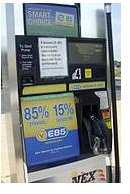Test for Ethanol Content in Gasoline
Why Test for Ethanol?
There’s a lot of money in ethanol as a fuel, and any time there’s a lot of money in something, it’s important to have a control like a test for content out there for consumers. The government is heavily subsidizing farmers to grow corn for ethanol, and the use of corn in this fuel has driven up the price of this basic grain, which has actually put a strain on food prices in Third World markets.
And if you’re at all involved in the fuels discussion, you know how precious gasoline is and how an increase of a few cents in the price per gallon can set off all sorts of economic currents. If the ethanol is cheaper, why wouldn’t the unscrupulous gas station owner, every now and then, bump that 10% up to 12%? Or 15%? Would consumers be able to decipher the damage in time to figure out where the bad gas came from?
Images

How to Test for Ethanol in Gasoline
This simple test for ethanol content is fairly easy to do at home. First, siphon out a small amount of your gas. Then, pour some of it into a measuring cup. If you can find a graduated cylinder that holds 100 mL at an educational or science supply store, that would be ideal, as it will make calculating percentages easier. If you have the graduated cylinder, pour gasoline up to the 50-mL mark.
Now, add 50 mL of water to the cylinder. Put your finger over the top of the cylinder and shake it vigorously, then set it down for twenty minutes. As the sample sits, the alcohol will come out of the fuel and mix in with the water, and you will see a clear line where the alcohol/water mixture separates from the gasoline.
The gasoline will rise to the top, because it is lighter than water and alcohol. Remember that, initially, you had 50% gas and 50% water, with an unknown quantity of alcohol/ethanol in the gas. Now, let’s say that the line separating water and alcohol from gasoline is at the 80-mL mark. That means that 30 mL of the 50 mL that you had thought was gasoline was actually ethanol. That means that you bought 60% ethanol fuel for your car – which will be deadly for your engine.
60% Ethanol? Seriously?
It’s not realistic that you would come up with a 60% result in a test for ethanol content from gasoline you’ve bought at a retail store. Any store owner or wholesaler who doctored the fuel that much would be quickly exposed. The rubber in your fuel system’s hoses and seals can change shape and size, or weaken, when ethanol-added gasoline enters the system, which can lead to serious problems in a hurry, particularly for older cars.
However, the government has recently authorized E15 (15% ethanol content in gasoline) for cars manufactured in 2007 or later. Right now, that only represents about one car in five, even though retailers may now sell E15 to everyone. Drivers who own older cars are concerned that the increase in ethanol will lead to a reduction in engine power and gas mileage – not to mention those problems in the fuel system. While it is commendable to promote the use of such renewable energy forms as ethanol, the authorization of E15 may tempt station owners or wholesalers to creep up to E20 or so. This is one of several simple ways to test for ethanol in petrol/gasoline that can help you keep your retailers honest.
